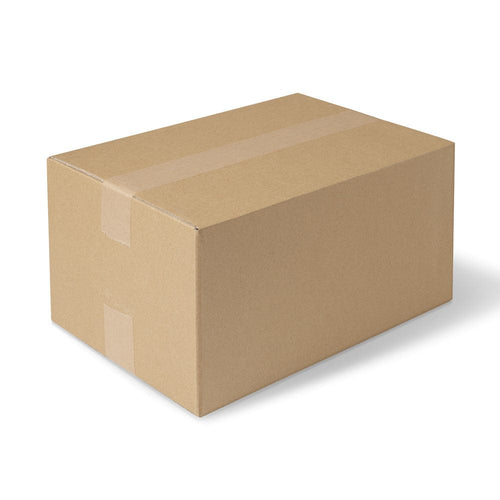Introduction to Ecommerce Boxes
Your product arrives in a box.
That box is your brand’s first handshake, your reputation on a doorstep, your promise kept (or broken) in transit.
Choosing the right ecommerce boxes isn’t just a packaging decision - it’s a profit decision. The right box protects margins, prevents returns, reduces shipping costs, delights customers, and shows off your brand values without saying a word. The wrong box? Crushed corners, spiralling costs, one-star reviews.
This guide cuts through the noise and shows you exactly how to select ecommerce boxes that fit, protect, and convert across product types, carriers, and budgets. You’ll learn how to match materials to SKUs, avoid costly mistakes, and build a packaging system that scales. By the end, you’ll be able to place orders with confidence and ship with absolute peace of mind.
Ready to dial in your packaging? Bookmark this guide and share it with your ops team.
Key Takeaways
- Size drives spend. Right-sizing your ecommerce boxes reduces weight, filler, and damage. Measure precisely, then standardise SKUs.
- Material matters. Choose board strength (e.g., E-flute vs. B/C-flute, single vs. double wall) based on product fragility and shipping distance.
- Branding can be lean. Use one-colour prints, branded tape, or inside prints to elevate unboxing without blowing budgets.
- Sustainability sells. Recyclable materials and minimal fill increase customer trust and loyalty.
- Think carrier-first. Design boxes to comply with courier limits and pass drop/edge/crush tests.
- System > single box. Build a modular set of sizes and inserts that cover 80–90% of orders.

Understanding Ecommerce Boxes
What Are Ecommerce Boxes?
Ecommerce boxes are shipping cartons tailored for direct-to-consumer fulfillment. Unlike retail cartons, they’re built to survive conveyor belts, sortation drops, and last-mile handling. They balance three jobs: protection, presentation, and cost control. Think corrugated mailers, RSC cartons, and die-cut boxes with features like tear strips, peel-and-seal closures, and return-ready designs.
Types of Ecommerce Boxes Available
- Mailer Boxes (Die-Cut Mailers): Sturdy, self-locking, great for branded unboxing. Ideal for apparel bundles, curated kits, and subscriptions.
- RSC Cartons (Regular Slotted Containers): The classic shipping box-efficient to produce, highly versatile, easy to stock in multiple sizes.
- Bookfold / Literature Mailers: Low-profile, adjustable spine-perfect for books, slim tech, and framed prints.
- Double-Wall Cartons: For heavy, fragile, or stacked pallet shipments that need extra compression strength.
- Custom Inserts & Partitions: Corrugated, pulp, or foam structures that immobilise products inside the box.
Benefits of Using Specialised Ecommerce Boxes
- Damage prevention: Right board grade + snug fit = fewer returns and replacements.
- Lower shipping costs: Optimised dimensions reduce dimensional weight and filler.
- Faster pack times: Self-locking mailers and kitted inserts speed up fulfillment.
- Brand lift: Clean print, smart unboxing, and eco cues increase perceived value.
- Scalability: Standardised SKUs simplify reorders and inventory management.
Start with 3–5 core sizes and add inserts for high-risk SKUs.
Key Factors to Consider When Choosing Ecommerce Boxes
Box Size and Product Dimensions
Measure L × W × H of your product - then add the minimal clearance needed for inserts or protective wrap. Over-boxing triggers weight charges and stuffing void fill wastes time and money. Aim for tight tolerances: 6–10 mm clearance per side for snug packs; up to 20 mm for mixed-kit orders. Create a size matrix to map each SKU (or SKU family) to the closest box.
Material Strength and Durability
- E-flute / F-flute: Thinner, crisp print, great for small items and branded mailers.
- B-flute / C-flute: The everyday workhorses for RSCs; good crush resistance.
- BC double-wall: For heavy loads, fragile items, and long-haul routes.
- Kraft liners hide scuffs better and project a natural, eco-forward aesthetic.
Consider ECT (Edge Crush Test) and BCT (Box Compression Test) relative to stacking and transit conditions. If your parcels ride pallets or face long carrier networks, upgrade board strength before you upgrade void fill.
Customisation and Branding Options
- One- or two-colour flexo on kraft = elevated look at low cost.
- Inside print keeps the exterior discreet (reducing theft risk) while delivering an “unboxing moment.”
- Branded tape, tissue, or a thank-you card adds personality without changing box SKUs.
Cost-Effectiveness and Budget Planning
Total cost = box + print + inserts + tape + labour + freight + damage rate.
- Consolidate sizes to hit price breaks.
- Optimise cube to lower carrier fees.
- Choose modular inserts over new box SKUs for special launches.
- Track damage and return reasons monthly; if a SKU slips, upgrade board or add an insert - don’t blanket-upgrade everything.
Run a quick cost-per-order analysis before approving any new box SKU.

Matching Box Types to Product Categories
Clothing and Apparel
Soft goods love ecommerce boxes or padded mailers. Prioritise speed: self-locking mailers + sized poly or tissue wrap. If you sell heavier denim/knitwear bundles, step up to B-flute mailers. Add a return-ready strip and a size exchange card to reduce friction.
Electronics and Gadgets
Think precision and immobilisation. Use double-wall RSCs or rigid mailers plus die-cut inserts that hold devices and accessories. Antistatic bags for components, corner protection for screens, and a small tamper-evident seal on the flap for trust.
Fragile or Breakable Items
For glass, ceramics, and candles, use double-wall cartons with suspension or molded pulp inserts. Ensure 2–5 cm of protective buffer from each wall. For heavy jars, add partition dividers and test drops at multiple orientations (corner/edge/flat).
Beauty and Wellness Products
Mixed sizes, lots of SKUs. Go with modular inserts (corrugated or pulp) inside a printed mailer. Protect pumps and droppers with neck collars or clip-in retention. Keep liquids upright with snug cavities and leak-resistant seals.
Not sure which insert to choose? Start with corrugated prototypes, they’re fast and recyclable. Order corrugated prototypes via our Custom Box Builder (small MOQ custom boxes perfect for trialing sizes).
The Role of Eco-Friendly Ecommerce Packaging
Why Sustainability Matters in Ecommerce
Customers judge your values the moment they open a box. Minimalist, recyclable eco-friendly sustainable packaging signals responsibility and sophistication. It also reduces weight and cost - eco isn’t just ethics; it’s economics.
Recyclable and Biodegradable Box Materials
- FSC-certified corrugated with water-based inks.
- Paper-based void fill (honeycomb wrap, kraft paper) over plastic air pillows.
- Molded fiber inserts instead of foam.
- Monomaterial systems (all paper-based) to simplify recycling.
Consumer Perception and Eco-Conscious Branding
Print recycling cues and a short sustainability message inside the lid. Offer a reuse-friendly design (clean interior, peel-and-seal for returns). When customers feel good about your packaging, they feel good about your brand and they tell friends.
Shift one SKU at a time to a monomaterial pack and track reviews + costs.

Shipping and Logistics Considerations
Compatibility with Courier Services
Every carrier has size/weight thresholds that trigger surcharges. Build your box lineup to stay under those breakpoints. Avoid odd shapes and weak seams that snag on conveyors. Labels should sit on flat, scannable panels - no over-the-edge wraps.
Packaging for Reduced Shipping Costs
Aim for dimensional efficiency: smallest box that safely fits the product + insert. Use mailers for slim items and multi-depth cartons for variable heights. Keep finished weights in lower pricing tiers where possible. Less void fill = faster packing and fewer claims.
Box Testing and Performance Under Transit
- Drop tests: corner, edge, flat - at realistic heights.
- Shake/vibration tests for long-distance shipments.
- Compression checks for stacked storage.
- Real-world pilots: ship to team members across zones and log condition + photos.
Document pass/fail criteria and lock them into your packaging SOP.
Step-by-Step: How to Choose the Right Ecommerce Boxes
- Audit your SKUs. Group by size, weight, and fragility. Flag high-damage and high-return items.
- Map to a size matrix. Choose 3–5 core box sizes that cover 80–90% of orders.
- Select board grades. Assign E/B/C or double-wall based on risk and route length.
- Design inserts. Start with corrugated die-cuts for immobilisation; upgrade to molded fiber if needed.
- Prototype + print. Begin with one- or two-colour artwork; add inside print later if ROI positive.
- Run transit tests. Drop, shake, compress - log results and iterate.
- Validate with carriers. Ensure sizes avoid surcharges and labels scan cleanly.
- Roll out + measure. Track damage rate, pack time, cost per order. Optimise quarterly.
Use this step list as your packaging RFP brief to save weeks of back-and-forth.
Common Mistakes to Avoid
Ignoring Box Sizing Guidelines
“Large” isn’t a spec. Over-sized boxes balloon weight and invite damage from product rattle. Measure SKUs precisely and right-size every time.
Choosing Aesthetics Over Functionality
Beautiful boxes that crush in transit aren’t beautiful. Prioritise board grade, inserts, and closure strength; then layer branding that travels well (e.g., kraft + one-color).
Overlooking Shipping Regulations
Lithium batteries, aerosols, and cosmetics may require special labeling or packaging. Skipping compliance risks delays and fines. When in doubt, verify and adjust your packaging SOPs.
Run a quarterly “packaging health check” to catch these before they cost you.
To Wrap
Your box is a profit lever and a brand stage. With a small, smart lineup of ecommerce boxes, the right board grades, and modular inserts, you’ll cut costs, cut damages, and elevate unboxing - without adding complexity. Start lean, test hard, iterate fast. Your customers, and your margin, will thank you.
Ready to ship smarter? Choose Boxes 24.
Every order still lands in a box - the first handshake at the door. Pick the right one and you protect margin, prevent returns, lower shipping costs, and deliver a brand moment worth sharing. That’s exactly what Boxes 24 is built for.
- Right-sized ranges that cut weight, filler and damage.
- Quality board grades & mailer styles engineered for real-world transit.
- Eco-forward options (paper-based systems, recyclable materials) without the premium price feel.
- Small MOQs so you can test, learn, and scale with confidence.
- Simple branding - one/two-colour, inside print for standout unboxing.
- Helpful humans to map your SKUs to the perfect 3–5 box lineup.
Shop our ecommerce boxes to build a cost-cutting, damage-proof setup - then trial custom sizes with corrugated prototypes via our Box Builder (small MOQ, perfect for testing). Ship safer. Spend smarter. Wow customers.
Frequently Asked Questions
What size box should I use?
Use the smallest box that allows for safe clearance and inserts - typically 6–10 mm per side for snug packs.
What’s the difference between mailers and RSC cartons?
Mailers are die-cut, self-locking, and presentation-forward; RSCs are classic shipping cartons - efficient, scalable, and versatile.
Do I need double-wall corrugate?
Only for heavy, fragile, or long-haul shipments that face stacking and compression. Otherwise, single-wall with the right insert often works.
Are branded boxes worth it?
Yes, when done economically. Start with one-colour kraft or inside print. Measure lift in reviews, UGC, and repeat rate.
What’s the most eco-friendly option?
Monomaterial recyclable paper systems (corrugated board + paper inserts) with water-based inks and minimal void fill.
How do I reduce damage rates fast?
Add immobilising inserts, upgrade board where needed, and run targeted drop tests on problem SKUs.





























